A Fantastic Phrasing
“One of those pictures is on my desk now; I am basting what looks like a twenty-pounders, balanced precariously on the open door of the oven that preceded my new stove. There are children and dogs underfoot, and grownups hovering with pot holders and coffee cups in their hands. We are all laughing. Thanksgiving looks easy, and it probably was, back in those early feminist days before the idea of the perfect meal invaded the heads of otherwise accomplished women, convincing them that voluntary servitude in the kitchen was the secret of their liberation.”
Pretty killer phrasing, no? And certainly applicable to many people, not just women.
Plastic Bodies
The overzealous Photoshoppers strike again! Demi Moore missing a chunk of leg on W magazine cover
BY TRACY MILLER DAILY NEWS STAFF WRITER
Thursday, November 19th 2009, 1:30 PM
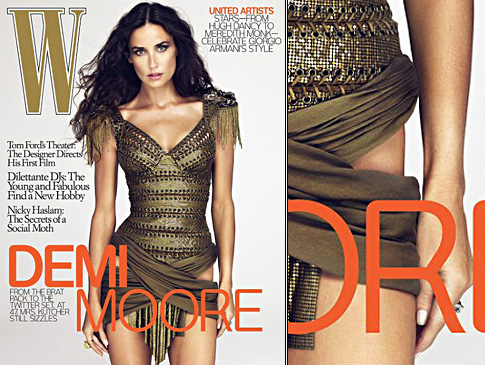
The December issue of W magazine features Demi Moore on its cover - minus a piece of her leg (r.).
Demi Moore has repeatedly denied going under the knife, but that didn't stop an overzealous photo editor from taking a little off her leg.
Looking closely at Moore's recent cover of W magazine, it's clear that something's amiss. The top of her left leg (right side of the photo), visible above a draped Balmain sarong, is noticeably thinner than the portion of leg below the sarong, creating an unnatural - and seemingly anatomically impossible - effect.
A spokesperson for the magazine told Jezebel.com that photographers Mert Alas and Marcus Piggot "did not do anything unusual or out of the ordinary on Demi Moore for the photo on the cover of W." The magazine said the retouching was done in-house by Alas and Piggott's staff.
W also added, "Demi is an extraordinary beautiful woman and we feel our cover reflects that."
In that case, one would think they'd want to show more leg, not less.
Post here.
The Return of Shoulder Pads
Rihanna’s Love of Shoulder Pads
Posted by Kate Bello in Apparel, FASHION TRENDS on 05 22nd, 2009 | no responses
Shoulder pads. They’re back…Well, according to Rihanna. Who knows if this will go mainstream, but I have a feeling in the next year or so, we will be seeing shoulder pads on the streets and it will be the hot new thing. It’s already hit fashion week, now the celebrities are flaunting strong shoulders and yes, mark my words they will be in mainstream stores by Fall, if not sooner. If you lived through the 80s, you probably thought they would never return, I mean, I wouldn’t say they’re exactly flattering. But 80s fashion is back with a vengeance, even those trends you swore you would never wear again. What’s next? Permed hair and bike shorts?
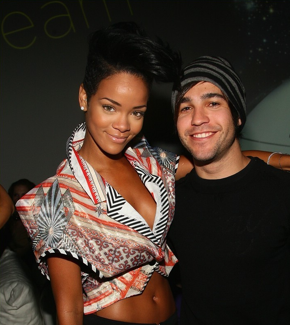
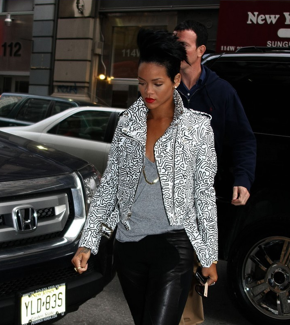 Now those are some big shoulders! I can’t decide whether I like this or not. In a way it’s cute. It’s definitely updated so in some ways it’s fresh and new.
Now those are some big shoulders! I can’t decide whether I like this or not. In a way it’s cute. It’s definitely updated so in some ways it’s fresh and new.The post is here.
Marketing to Men
Pimp My Bed: The Male Sleep Lair

By RAY A. SMITH
Bed makers are manning up.
After years of catering to women, manufacturers are setting their sights on men. The new macho mattresses they're introducing have "muscle-recovery properties" and cooling technology, on the theory that men are more likely to feel too hot in bed. The bed frames feature built-in TVs, iPod docking stations, wine coolers, safes and other guy-friendly gadgetry.
Dave Shapiro, a 33-year-old real-estate investor in Philadelphia, paid $30,000 for a Hollandia International adjustable bed that offers a built-in 32-inch Sony flat-screen TV, surround-sound speakers and outlets for laptops. "The best thing is the TV," he says. "You don't have to get up."
Mr. Shapiro admits his wife was less than enthusiastic when he picked the bed out six months ago. He delighted in showing her that the TV could be lowered into the footboard via remote, and he let her pick out the color and pattern of the mattress fabric. His wife declined to comment.
The full article is here.
Megan Fox as an Example of Agentive Possibilities

By LYNN HIRSCHBERG
Published: November 11, 2009
Megan Fox is a fox. And not just in the way you might think if you’ve seen her in a tiny bikini in a men’s magazine or leaning over the hood of a ’76 Camaro in “Transformers.” Yes, Fox is beautiful and often scantily clad, but dozens of beautiful girls arrive in Hollywood every day who are more than happy to pose nearly naked. Unlike them, Fox has a quality that sets her apart: Fox is sly. Canny. A devoted student of stardom, past and present, she knows how to provide her own color commentary — a narrative to go with the underwear. In the age of the 24-hour news cycle and hungry blogs, Fox has supplied a seemingly endless stream of tantalizing quotes. She has detailed her fling with a stripper named Nikita; compared Michael Bay, the director of “Transformers,” to Hitler; and revealed that she has her boyfriend’s name tattooed “next to my pie.” Fox has a provocative way of describing any situation: her girl-on-girl kiss in her latest film, “Jennifer’s Body,” is “like crazy kiddie porn”; Disney’s “High School Musical” is about pedophilia (if you watch it, as she did, after getting high); and the reigning heartthrob Robert Pattinson is too young and too pretty to be sexually compelling. “I would eat Robert Pattinson,” she said.
The full article is here.
Reality v. Fantasy
posted by CHARLES MUDEDE on TUE, NOV 17, 2009 at 8:00 AM
Crime in the age of reality TV:

PHOENIX — There are new allegations against Sheriff Joe Arpaio as he conducts another one of his controversial crime sweeps.
The sheriff is targeting smugglers; but Arpaio himself is the target of critics who say this time he's really just playing for the press.
The sheriff shot down those claims, saying he’s dealing with increasingly sly, innovative smugglers, and this operation — targeting smugglers on highways — is needed.
But protesters accuse Sheriff Arpaio of staging the latest crime sweep for a national TV crew.
"This is nothing but grandstanding for national media who was asked to stay so they could witness a sweep,” said protester Lydia Guzman.
The sheriff's response?
"Network? What network? What is it? ABC? Oh, so I arranged this because ABC is here? The answer is no,” he said. “We happened to be here and they're smart enough to know they might want to film the sheriff."
We cannot separate this sort of thing from the balloon boy hoax. What is needed more than ever is a stricter regulation of the border not between Mexico and the US but between entertainment and life. Reality shows are not about reality; reality is not about reality shows.
Original post is here.
"These jokes are dangerous in the wrong hands"
The only movie they kept offering me over and over was fuckin' Soul Plane. They kept giving me the script and I'd say, 'I passed on this script.' And it would just keep coming back. 'No, I don't want to do Soul Plane!' . . . Maybe the pendulum is swinging back and people want entertainment that has a little more substance. Dude, the number-one song on the radio is 'Shake That Laffy Taffy.' There's a group of people out there that rebel against that. Like, this is the shit you're cramming down my throat? 'Shake That Laffy Taffy'? . . .
[...]
This is the crux of why Dave Chappelle left the show, why he went to Africa to breathe amid his stunning success, why he prefers life in Ohio. He doesn't like to feel, as an artist, as a comedian, as a black man in America, like he is being controlled, told what he should and should not be doing--ever. This is why, at the close of each episode of Chappelle's Show, there is that image of a shirtless Chappelle with slave shackles on his wrists. This is why Chappelle prefers live stand-up to television, and especially to Hollywood films. And this is why, throughout the course of these final few hours together, Chappelle repeatedly brings up David Mamet's recent Harper's essay, "Bambi v. Godzilla: Why Art Loses in Hollywood," as well as Spike Lee's hotly debated flick Bamboozled.
Full article here.
You can follow YouTube links to more from the Inside the Actor’s Studio interview.
By RANDY COHEN
The Issue

photoshopdisasters.blogspot.com
A Ralph Lauren window display in Sydney, Australia, shows a digitally altered image of a model.
A Ralph Lauren ad, featuring a model with hips narrower than her head — so cartoonish, so grotesque, so right for Halloween — has become the latest focus of the already ongoing criticism of digitally altered fashion spreads, even though it ran only in Japan. Foes see such images as harming women by promoting a standard of beauty so false that it can be achieved solely by manipulating a photograph of an already slender model. This image is an extreme example of what happens to many ads, a practice that has become so dubious that some governments are taking action. Should ads using electronically altered images be banned?
The Argument
Yes, say Britain’s Liberal Democrats. At their party conference in September, they called for the prohibition of faked photos that present “overly perfected and unrealistic images” of women in ads aimed at children and warning labels on similar ads aimed at adults. Jo Swinson, a member of Parliament, noted the damage done to women by an unceasing flow of such images, citing rising rates of cosmetic surgery and eating disorders and the anxiety of women constantly judged on their appearance.
She has a point. It is commonplace that women are pressured to meet an artificial standard of beauty. These ads affect men too, giving them false expectations of how women look. Now technology makes that standard unobtainable even by professional beauties, as is evident in paired photographs, pre- and post-Photoshop, of Jessica Alba, Keira Knightley and even, anomalously, Andy Roddick.
French parliamentarians have called not for a ban but for warning labels on manipulated images. The representative Valérie Boyer, a leading proponent of such a law, sees it as an ordinary matter of truth in advertising. “Rules on food-labeling let consumers know the origins of the contents and the presence of things like additives and preservatives,” she said. What’s wrong with “informing them when photographs have also been modified from their original form?”
For us Americans, a ban on such ads might clash with our ideas about free expression, even when what’s expressed is that a particular mascara will lengthen your eyelashes, perhaps by as much as six inches, like twin fans glued to your eyelids, if I catch the implied promise. But we already accept labels that list a product’s ingredients or assess its nutritional value or warn of dangers in its use. Similar transparency should apply to phony-baloney advertising photographs.
There is the counterargument that fashion ads are inherently false: preternaturally beautiful models are worked over by makeup artists and hair stylists, illuminated by lighting designers and shot by sophisticated photographers. In such a context, where can we draw the line on deceit? Here’s where: with the electronic manipulation of a photograph. It may be an arbitrary limit, but we set arbitrary limits all the time. The 55-mile-an-hour speed limit draws on the knowledge of traffic engineers, but it is not a manifestation of some immutable law of nature.
It could also be argued that a labeling law, equitably applied, would require warnings on nearly all ads, including those that alter reality in other ways. For example, few roads are as serenely traffic-free as those in car commercials (and indeed some automobile ads on TV already note that they were photographed on a closed course). But here’s the distinction: Although that open road deliberately conveys a bogus
sense of driving delight, the road itself is not the product. The car is the product. In fashion ads, however, whether for clothes or makeup or shampoo, the model’s beauty is the product, or at least the direct result the product is meant to achieve. Because that beauty cannot be obtained via the proffered merchandise but only through a tricked-out photo, this is a case of false advertising.
Even if the sort of labeling law proposed in France and the U.K. proved to be the camel’s nose in the tent and proliferated to govern all sorts of ads, in all sorts of ways, that’s fine. There is an ethical case for pasting a label on, for instance, overly optimistic beer ads: “Use of this product will not win you the love of magnificent women, unless they drink the beer. And plenty of it.”
It’s easy to imagine even broader warnings that would flag beauty achieved not only electronically but also medically, denoting the particular bits on a model that have been surgically enlarged, reduced or smoothed out. Eventually lingerie ads might require a page of boilerplate, like the ads for prescription drugs, but without restrictions on wearing any particular underwear while operating heavy machinery. Big pharma survived such requirements; big bra can do likewise.
A tougher charge to refute is that such warnings are ineffectual. Simply being told that you’re watching an ad, even a deceptive ad, does not inoculate you against its effects. We like to think we’re too savvy to be seduced by, say, a soda commercial, yet at the supermarket, we are strangely drawn to Coke. Or Pepsi. Or whichever cola ad includes adorable polar bear cubs. Apparently they’re quite thirst-quenching.
Full article here.
Example Articles

Challenge, Anyone?
By PAUL KEDROSKY
Published: September 20, 2009
ROGER FEDERER is getting teased, and not just because he lost the U.S. Open last week to Juan Martin del Potro. He is being mocked for his terrible eye. He challenged more calls in the U.S. Open than any other competitor, and yet he had one of the lowest success rates of any of the top players.
Insult to injury, right? Wrong. Federer is adept at challenging tennis calls, and he should challenge more of them — as should his rivals. Professional tennis players are almost certainly losing matches because of their unwillingness to do so.
Here’s how challenges work. Major tennis tournaments (like the U.S. Open) have multiple cameras arrayed around the court. This permits a simulated replay of a shot, showing to the millimeter where a ball landed on the court. So instead of futilely shouting, “You can’t be serious!” at linesmen and umpires, players can raise their hand immediately after a call and ask for a replay.
[The full article is here.]
THE RUBBER ROOM
The battle over New York City’s worst teachers.
by Steven Brill
AUGUST 31, 2009
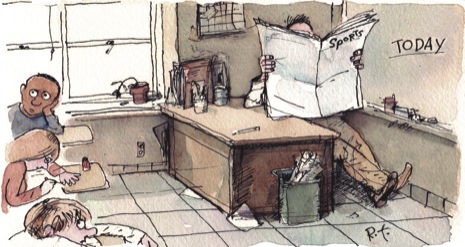
One school principal has said that Randi Weingarten, of the teachers’ union,“would protect a dead body in the classroom.”
In a windowless room in a shabby office building at Seventh Avenue and Twenty-eighth Street, in Manhattan, a poster is taped to a wall, whose message could easily be the mission statement for a day-care center: “Children are fragile. Handle with care.” It’s a June morning, and there are fifteen people in the room, four of them fast asleep, their heads lying on a card table. Three are playing a board game. Most of the others stand around chatting. Two are arguing over one of the folding chairs. But there are no children here. The inhabitants are all New York City schoolteachers who have been sent to what is officially called a Temporary Reassignment Center but which everyone calls the Rubber Room.
These fifteen teachers, along with about six hundred others, in six larger Rubber Rooms in the city’s five boroughs, have been accused of misconduct, such as hitting or molesting a student, or, in some cases, of incompetence, in a system that rarely calls anyone incompetent.
[The full article is here]

The Recession’s Racial Divide
By BARBARA EHRENREICH and DEDRICK MUHAMMAD
Published: September 12, 2009
WHAT do you get when you combine the worst economic downturn since the Depression with the first black president? A surge of white racial resentment, loosely disguised as a populist revolt. An article on the Fox News Web site has put forth the theory that health reform is a stealth version of reparations for slavery: whites will foot the bill and, by some undisclosed mechanism, blacks will get all the care. President Obama, in such fantasies, is a dictator and, in one image circulated among the anti-tax, anti-health reform “tea parties,” he is depicted as a befeathered African witch doctor with little tusks coming out of his nostrils. When you’re going down, as the white middle class has been doing for several years now, it’s all too easy to imagine that it’s because someone else is climbing up over your back.
Heads of State
Despite the sense of white grievance, though, blacks are the ones who are taking the brunt of the recession, with disproportionately high levels of foreclosures and unemployment. And they weren’t doing so well to begin with. At the start of the recession, 33 percent of the black middle class was already in danger of falling to a lower economic level, according to a study by the Institute on Assets and Social Policy at Brandeis University and Demos, a nonpartisan public policy research organization.
In fact, you could say that for African-Americans the recession is over. It occurred from 2000 to 2007, as black employment decreased by 2.4 percent and incomes declined by 2.9 percent. During those seven years, one-third of black children lived in poverty, and black unemployment — even among college graduates — consistently ran at about twice the level of white unemployment.
[The full article is here.]
Definitions
Sex -
Biological state of having male, female, genitalia (or both: intersexed) (Jennifer)
Gender -
A term encompassing the collective socially constructed roles, behaviors, and norms that an individual society considers to be ‘normal’ or ‘natural’ for males and females. (Matt)
Structure and Agency -
Structure – Our lives are largely shaped by social, cultural institutions; these institutions force you towards particular beliefs and situations
Agency – Although we may live within social and cultural institutions, people still have a large degree of control over the decisions they make
Structure & Agency – Although many Americans prefer to think of themselves as atomized individuals (not dependent, not needy), we must be willing to acknowledge the influence of social institutions over our lives to some degree (Meredith)
Normative-
Any action used to try and normalize something (Marquis)
Ideology -
Ideology is the lenses with which an individual sees the world. It consists of a set of ideas that direct an individual’s actions and beliefs. Each individual has a set of ideals that form their ideology. Moreover, a group of people may share the same beliefs and ideals, and thus have a shared ideology. (Lauren H.)
Power -
Refers to the authority one has over another, the ability of one to successfully influence another. (Katie S.)
Intersectionality -
Intersectionality: the theory that oppression and inequality are not the product of one thing feeling, or institution but a combination of many or all of them. E.g. race, gender, religion, class, and sexual orientation "intersect" and collectively discriminate to cause oppression. (Suzanne)
Bibbidi Bobbidi Boutique
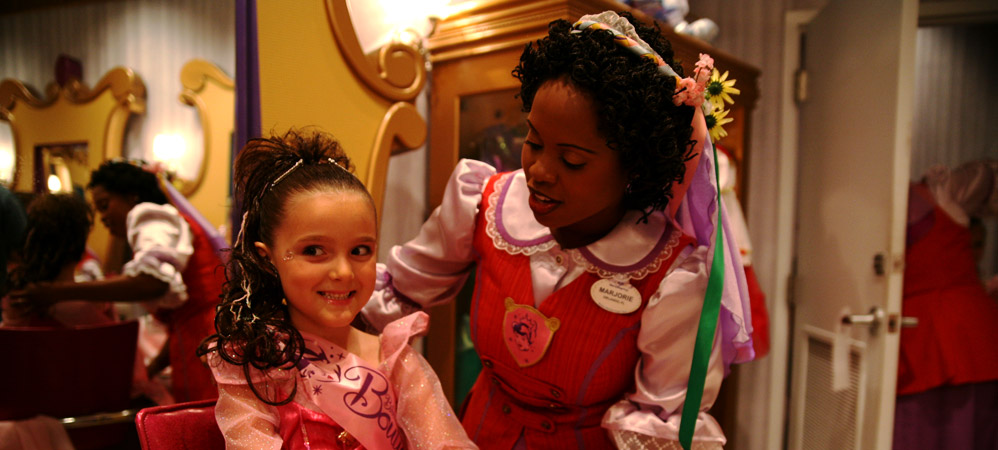
Bibbidi Bobbidi Boutique is a beauty salon where little girls are magically transformed into little princesses at 2 locations: World of Disney Store in Downtown Disney Area and Cinderella Castle at Magic Kingdom theme park.
It's hard not to feel as happy as a princess in this charming little boutique, owned by Cinderella's Fairy Godmother and operated by Fairy Godmothers-in-training. The boutique offers multiple hair styles, nail color, make-up and a total package including Disney Princess costume and photographs.
Girls 3 years old and above can choose from 3 hair styles — Fairytale Princess, Disney Diva and Pop Princess — in 3 available packages:
- Coach Package includes hairstyling and shimmering makeup — starting at $49.95 plus tax.
- Crown Package includes hairstyling, shimmering makeup and nails — starting at $54.95 plus tax.
- Castle Package includes the Crown Package plus the Imaging Package (one 6" x 8" and four 4" x 6" photos in a princess-themed photo holder) and complete costume of your choice with accessories — starting at $189.95 plus tax.
The optional Imaging Package includes one 6" x 8" and four 4" x 6" photos in a princess-themed photo holder.
The World of Disney Store location offers a wide variety of beautiful accessories — including ponytail hairpieces and tiaras.
Cool Dudes Package
Boys over 3 years old have their own special Cool Dudes Package, which includes colorful hair gel and confetti for $7.50 plus tax.
New Disney's Secret Star Makeover!
Be your own star, just like Hannah Montana, with a fantastic Disney's Secret Star makeover! Learn what's included in the makeover package.
[The website is here.]
From AA: I am not exactly surprised by the prices, but am surprised by how the price jumps between the crown and castle packages...
Reel Bad Arabs
I don't know if you have heard of or read Jack Shaheens works on the villification of Arabs in Hollywood. He has a great documentary which is on Youtube which specifically critiques Aladin along with scores of othe Hollywood films. Here is the link:
More Images of "Airbender"
We'll let the show speak for itself.
- Dec. 16th, 2008 at 12:00 PM

Many people have been telling us we shouldn't be offended. And of all the arguments we've been presented with this past week, the most common is also the most surprising: "These characters look white to me."
We considered writing an essay about the ethnic makeup of Avatar: The Last Airbender, but then we realized we could never be as eloquent on this topic as the show itself was.
For those of you who're interested in this issue but not familiar with the show, and for those fans who want a reminder of what we're fighting to preserve: an essay in images, spanning the length of the series and ending as the show itself tellingly chose to.



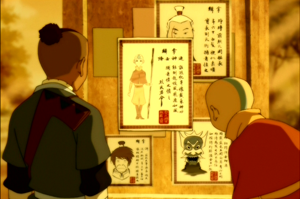



Whitewashing "The Last Airbender"
(From here)
Tuesday, January 20, 2009
New day in politics, same old racist world on the silver screen This past Monday, on Martin Luther King Jr.'s birthday, on the eve of Barack Obama's inauguration, I discovered that the casting of the four leading characters for the upcoming live-action movie, "The Last Airbender" (based on the TV show, “Avatar: The Last Airbender”) had gone entirely to white actors. I want—no, need—to say something about this.
This past Monday, on Martin Luther King Jr.'s birthday, on the eve of Barack Obama's inauguration, I discovered that the casting of the four leading characters for the upcoming live-action movie, "The Last Airbender" (based on the TV show, “Avatar: The Last Airbender”) had gone entirely to white actors. I want—no, need—to say something about this.
 I'm going to take a tip from President Barack Obama, and begin this with a little personal story.
When my brother and I were in high school, our favorite class was Drama. While we were rehearsing for the next day's class or participating in a school play or dancing it up at the after party, I don't think there was anything we liked more. During such times, it even surpassed our love of—dare I say it—comics. But we never even entertained the notion of actually pursuing it as a career. Not because we didn't want to, but because we had too much pride to spend our entire lives pretending to be Long Duk Dong, or a Chinese food delivery boy with one line, or a Kato to some Green Hornet. Or even worse, having our hearts broken over and over going after roles that specifically call for Asian Americans like "Avatar, The Last Airbender" only to see them go to white actors. Back in my Drama days in high school, I used to dream of being white so I could pursue acting.
With discrimination like this "Avatar" casting continuing to happen uncontested in Hollywood, my future kids will nurse the same pitiful wish.
And it infuriates me.
If my future kids feel a passion for acting, I want them to be able to pursue it just like any other American. If they're forced to give up that passion due to a genuine lack of talent or hard work, fine. But I don't want their dreams to be clipped at the bud by some unassailable, universally accepted dismissal of their existence on the face this country.
It's not fair. It's not right.
I'm going to take a tip from President Barack Obama, and begin this with a little personal story.
When my brother and I were in high school, our favorite class was Drama. While we were rehearsing for the next day's class or participating in a school play or dancing it up at the after party, I don't think there was anything we liked more. During such times, it even surpassed our love of—dare I say it—comics. But we never even entertained the notion of actually pursuing it as a career. Not because we didn't want to, but because we had too much pride to spend our entire lives pretending to be Long Duk Dong, or a Chinese food delivery boy with one line, or a Kato to some Green Hornet. Or even worse, having our hearts broken over and over going after roles that specifically call for Asian Americans like "Avatar, The Last Airbender" only to see them go to white actors. Back in my Drama days in high school, I used to dream of being white so I could pursue acting.
With discrimination like this "Avatar" casting continuing to happen uncontested in Hollywood, my future kids will nurse the same pitiful wish.
And it infuriates me.
If my future kids feel a passion for acting, I want them to be able to pursue it just like any other American. If they're forced to give up that passion due to a genuine lack of talent or hard work, fine. But I don't want their dreams to be clipped at the bud by some unassailable, universally accepted dismissal of their existence on the face this country.
It's not fair. It's not right.
 Before I go any further, it behooves me to spill some information on "Avatar, the Last Airbender" for those people who have no idea what it is. 1) It's the greatest, most ambitious animated action adventure TV series ever hatched in the U.S. A cartoon series for kids in which one epic story actually spans 3 entire seasons. A kid's show in which the characters actually grow and change and evolve! A cartoon which actually respects a kid's intelligence and vast imagination. Imagine that! 2) It's wholly and inarguably built around Asian (and Inuit) culture. Everything from to the costume designs, to the written language, to the landscapes, to martial arts, to philosophy, to spirituality, to eating utensils!—it's all an evocative, but thinly veiled, re-imagining of ancient Asia. (In one episode, a region is shown where everyone is garbed in Korean hanboks—traditional Korean clothing—the design of which wasn't even altered at all.) It would take a willful disregard of the show's intentions and origins to think this wouldn't extend to the race of the characters as well. You certainly don't see any blonde people running around in "Avatar." (I'm not saying that would have necessarily been a bad thing, I'm just stating the facts of the show and the world in which it is set.)
Just take a look for yourself.
Before I go any further, it behooves me to spill some information on "Avatar, the Last Airbender" for those people who have no idea what it is. 1) It's the greatest, most ambitious animated action adventure TV series ever hatched in the U.S. A cartoon series for kids in which one epic story actually spans 3 entire seasons. A kid's show in which the characters actually grow and change and evolve! A cartoon which actually respects a kid's intelligence and vast imagination. Imagine that! 2) It's wholly and inarguably built around Asian (and Inuit) culture. Everything from to the costume designs, to the written language, to the landscapes, to martial arts, to philosophy, to spirituality, to eating utensils!—it's all an evocative, but thinly veiled, re-imagining of ancient Asia. (In one episode, a region is shown where everyone is garbed in Korean hanboks—traditional Korean clothing—the design of which wasn't even altered at all.) It would take a willful disregard of the show's intentions and origins to think this wouldn't extend to the race of the characters as well. You certainly don't see any blonde people running around in "Avatar." (I'm not saying that would have necessarily been a bad thing, I'm just stating the facts of the show and the world in which it is set.)
Just take a look for yourself.
 I was speaking with Gene Yang (author of "American Born Chinese" and National Book Award nominee) about the casting and he said it best: "It's like a white Asian fetishist's wet dream. All the Asian culture they want, without any of the Asian people."
I was speaking with Gene Yang (author of "American Born Chinese" and National Book Award nominee) about the casting and he said it best: "It's like a white Asian fetishist's wet dream. All the Asian culture they want, without any of the Asian people."
 J.R.R. Tolkien never specifically described his central human, and human-like, characters as being "Caucasian" or "European" (as far as I know) in "The Lord of the Rings", but it would be pretty stupid to think they weren't when the entire story and the world in which it was set came from an obvious extrapolation of medieval Europe. Why should it be any different for Avatar?
J.R.R. Tolkien never specifically described his central human, and human-like, characters as being "Caucasian" or "European" (as far as I know) in "The Lord of the Rings", but it would be pretty stupid to think they weren't when the entire story and the world in which it was set came from an obvious extrapolation of medieval Europe. Why should it be any different for Avatar?
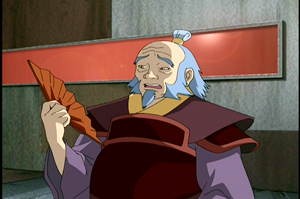 Or let me draw a closer parallel—imagine if someone had made a “fantasy” movie in which the entire world was built around African culture. Everyone is wearing ancient African clothes, African hats, eating traditional African food, writing in an African language, living in African homes, all encompassed in an African landscape...
...but everyone is white.
How offensive, insulting, and disrespectful would that be toward Africans and African Americans? How much more offensive would it be if only the heroes were white and all the villians and background characters were African American? (I wince in fear thinking about "The Last Airbender" suffering from the latter dynamic—which it probably will.)
Or let me draw a closer parallel—imagine if someone had made a “fantasy” movie in which the entire world was built around African culture. Everyone is wearing ancient African clothes, African hats, eating traditional African food, writing in an African language, living in African homes, all encompassed in an African landscape...
...but everyone is white.
How offensive, insulting, and disrespectful would that be toward Africans and African Americans? How much more offensive would it be if only the heroes were white and all the villians and background characters were African American? (I wince in fear thinking about "The Last Airbender" suffering from the latter dynamic—which it probably will.)
 Or imagine if they remade "Shaft" or "Zorro", but cast white actors to play the lead roles. It would be outrageous, right? Well, this Avatar casting is no different. But curiously, when similiar offenses are committed at the expense of Asian Americans, and Asian American men in particular, this sort of behavior goes mostly ignored by the press and the people involved.
Or imagine if they remade "Shaft" or "Zorro", but cast white actors to play the lead roles. It would be outrageous, right? Well, this Avatar casting is no different. But curiously, when similiar offenses are committed at the expense of Asian Americans, and Asian American men in particular, this sort of behavior goes mostly ignored by the press and the people involved.
 To show you what I mean, here's a snippet from a recent article on MTV.com:
Due in theaters in summer 2010, "Airbender" has already begun to face a bit of controversy over the casting of white actors like Rathbone, Ringer and McCartney to play Asian characters — a concern the actor was quick to dismiss. "I think it's one of those things where I pull my hair up, shave the sides, and I definitely need a tan," he said of the transformation he'll go through to look more like Sokka. "It's one of those things where, hopefully, the audience will suspend disbelief a little bit."
If Rathbone had gotten the role of "Shaft," and got a perm and a "tan" to play that character (and I don't mean in a self-conscious, subversive way like Robert Downey Jr. in "Tropic Thunder"), there would be a shit storm of outrage from all sectors of America, not just the African American community. It would be a headline across every newspaper, and I highly doubt that production would make it to filming. But when Joel Grey taped his eyes "slanty" and colored his skin to play a Korean man in "Remo Williams" (in 1985! we're not talking ancient history here), it went virtually unnoticed. How was that even allowed to happen? How is it continuing to happen, here in 2009, at the eve of Obama's inauguration (as I type this.) Why this double standard?
To show you what I mean, here's a snippet from a recent article on MTV.com:
Due in theaters in summer 2010, "Airbender" has already begun to face a bit of controversy over the casting of white actors like Rathbone, Ringer and McCartney to play Asian characters — a concern the actor was quick to dismiss. "I think it's one of those things where I pull my hair up, shave the sides, and I definitely need a tan," he said of the transformation he'll go through to look more like Sokka. "It's one of those things where, hopefully, the audience will suspend disbelief a little bit."
If Rathbone had gotten the role of "Shaft," and got a perm and a "tan" to play that character (and I don't mean in a self-conscious, subversive way like Robert Downey Jr. in "Tropic Thunder"), there would be a shit storm of outrage from all sectors of America, not just the African American community. It would be a headline across every newspaper, and I highly doubt that production would make it to filming. But when Joel Grey taped his eyes "slanty" and colored his skin to play a Korean man in "Remo Williams" (in 1985! we're not talking ancient history here), it went virtually unnoticed. How was that even allowed to happen? How is it continuing to happen, here in 2009, at the eve of Obama's inauguration (as I type this.) Why this double standard?
 Now if you're a progressive Asian American you might be saying that I'm barking up the wrong tree. That perhaps it's better not to perpetuate the stereotype of Asians being nothing but karate-chopping, fortune cookie wisdom spouting monks. But the fact of the matter is these kinds of films are going to be made whether we like them or not. It's a genre, like “Lord of the Rings” and its ilk—the western counterpart to films like “The Last Airbender” or “Forbidden Kingdom”, that's way too popular to ever go away. Almost everyone craves adventure and mythic grandeur. Films like “Avatar”, just in terms of genre, are dime a dozen in Asia itself after all. So since Hollywood is never going to stop making these kinds of films, I think we should protect them and make sure they're done respectfully, as well as pursuing intelligent independent movies that are reflective of Asian Americans in real life.*
And the reason this miscasting is particularly stinging when it comes to “Avatar” is because of the high quality of the source material. "The Last Airbender" has the potential to be something like "Star Wars"—something with lasting value that could give new heroes to your average household in America. And to have something for Asian American kids, and ethnic kids in general, to look up to. To let them know heroes can also look like them and speak fluent English like them. I think it could give immeasurable confidence and pride to these under-represented kids to have something like "Avatar" if it turns out to be as good as I hope. There's no reason Asian Americans should have to forsake "Star Wars" for "Citizen Kane." Both kinds of films have their merits and places in culture and it would be healthy to strive for both--to have Asian Americans and all minority Americans be a part of the entire spectrum
Now if you're a progressive Asian American you might be saying that I'm barking up the wrong tree. That perhaps it's better not to perpetuate the stereotype of Asians being nothing but karate-chopping, fortune cookie wisdom spouting monks. But the fact of the matter is these kinds of films are going to be made whether we like them or not. It's a genre, like “Lord of the Rings” and its ilk—the western counterpart to films like “The Last Airbender” or “Forbidden Kingdom”, that's way too popular to ever go away. Almost everyone craves adventure and mythic grandeur. Films like “Avatar”, just in terms of genre, are dime a dozen in Asia itself after all. So since Hollywood is never going to stop making these kinds of films, I think we should protect them and make sure they're done respectfully, as well as pursuing intelligent independent movies that are reflective of Asian Americans in real life.*
And the reason this miscasting is particularly stinging when it comes to “Avatar” is because of the high quality of the source material. "The Last Airbender" has the potential to be something like "Star Wars"—something with lasting value that could give new heroes to your average household in America. And to have something for Asian American kids, and ethnic kids in general, to look up to. To let them know heroes can also look like them and speak fluent English like them. I think it could give immeasurable confidence and pride to these under-represented kids to have something like "Avatar" if it turns out to be as good as I hope. There's no reason Asian Americans should have to forsake "Star Wars" for "Citizen Kane." Both kinds of films have their merits and places in culture and it would be healthy to strive for both--to have Asian Americans and all minority Americans be a part of the entire spectrum
 And many non-Asian Americans might be saying, "Relax! Things are getting better—hey, look at 'Harold and Kumar'!" But what they may be overlooking is that for every "Harold and Kumar" (as in 2), there are hundreds of "Avatar, The Last Airbender"s and "21"s.
The movie "21" (released last year!) was supposed to be based on the real life exploits of some Asian American MIT students. But of course, a Hollywood studio just couldn't bear to put an Asian American in the leading role. Instead the role was given to Jim Sturgess. To add insult to injury, Sturgess' sidekick friends were played by Aaron Yoo and Liza Lapira. They're both perfectly capable actors who could've pulled off the role just as well as Sturgess. But Yoo and Lapira were obviously just tossed in as a lame attempt to deflect accusations of discrimination which were sure to follow.
Again, let me repeat that this movie was made last year, in 2008. You may think it unbelievable, but things really haven't changed at all since the time Bruce Lee was tossed aside for David Carradine in "Kung Fu." How could this much time have passed and so little progress been made?
And many non-Asian Americans might be saying, "Relax! Things are getting better—hey, look at 'Harold and Kumar'!" But what they may be overlooking is that for every "Harold and Kumar" (as in 2), there are hundreds of "Avatar, The Last Airbender"s and "21"s.
The movie "21" (released last year!) was supposed to be based on the real life exploits of some Asian American MIT students. But of course, a Hollywood studio just couldn't bear to put an Asian American in the leading role. Instead the role was given to Jim Sturgess. To add insult to injury, Sturgess' sidekick friends were played by Aaron Yoo and Liza Lapira. They're both perfectly capable actors who could've pulled off the role just as well as Sturgess. But Yoo and Lapira were obviously just tossed in as a lame attempt to deflect accusations of discrimination which were sure to follow.
Again, let me repeat that this movie was made last year, in 2008. You may think it unbelievable, but things really haven't changed at all since the time Bruce Lee was tossed aside for David Carradine in "Kung Fu." How could this much time have passed and so little progress been made?
 How? Because Asian Americans don't have the support of liberal Americans at large the way some other minorities do. The reason Barack Obama won the presidency, when so many African American politicians before him couldn't get a foothold, is because a candidate finally came along that garnered the support of everyone in America, not just his community (and deservedly so). Now I'm not equating the presidency with something as trivial as a movie role, but this issue is still something deserving of support from outside the Asian American community, as well as within, to help fight discrimination for everyone.
How? Because Asian Americans don't have the support of liberal Americans at large the way some other minorities do. The reason Barack Obama won the presidency, when so many African American politicians before him couldn't get a foothold, is because a candidate finally came along that garnered the support of everyone in America, not just his community (and deservedly so). Now I'm not equating the presidency with something as trivial as a movie role, but this issue is still something deserving of support from outside the Asian American community, as well as within, to help fight discrimination for everyone.
 So if you're someone who believes in equality—if you want to see all of America reflected in our world's most popular and influential narrative art form—I implore you, particularly if you aren't Asian yourself, to write a letter of complaint to Paramount or show your displeasure in some form. If you have a blog, please post something to shame the producers of this film or feel free to distribute my little essay here. Especially if you're a professional in the arts or entertainment industry. With a strong enough voice, perhaps we can force them do what's right by recasting this movie. And lastly, if this effort fails, please boycott this film when it's released in the summer of 2010. Let Paramount and the rest of Hollywood know that this kind of blatant discrimination isn't acceptable to us. Not just for Asian Americans, but for all minorities in our country who never see themselves reflected in our country's media.
So if you're someone who believes in equality—if you want to see all of America reflected in our world's most popular and influential narrative art form—I implore you, particularly if you aren't Asian yourself, to write a letter of complaint to Paramount or show your displeasure in some form. If you have a blog, please post something to shame the producers of this film or feel free to distribute my little essay here. Especially if you're a professional in the arts or entertainment industry. With a strong enough voice, perhaps we can force them do what's right by recasting this movie. And lastly, if this effort fails, please boycott this film when it's released in the summer of 2010. Let Paramount and the rest of Hollywood know that this kind of blatant discrimination isn't acceptable to us. Not just for Asian Americans, but for all minorities in our country who never see themselves reflected in our country's media.
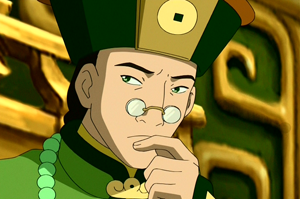 African Americans kids can finally, realistically dream of being president one day. Can't Asian American kids—perhaps my kids—at least dream of being something as relatively insignificant as central characters in some escapist Hollywood movie where everything is stolen from their heritage?
Can't they be a part of America too?
Derek Kirk Kim
01-19-09
African Americans kids can finally, realistically dream of being president one day. Can't Asian American kids—perhaps my kids—at least dream of being something as relatively insignificant as central characters in some escapist Hollywood movie where everything is stolen from their heritage?
Can't they be a part of America too?
Derek Kirk Kim
01-19-09
Disney's First Black Princess
Disney's 'subservient' black princess animates film critics
By Arifa Akbar, Arts Correspondent
Thursday, 17 July 2008

AP
The character of Princess Tiana had to be rewritten
When Disney announced it was casting its first black princess for its latest animation film, the African-American heroine was hailed as a positive role model for little girls and an ambitious marketing ploy, not to mention an attempt to ward off the allegations of racism that have lurked since the heyday of Walt Disney Productions in the 1940s and 1950s.
But now the film studio finds itself fending off a chorus of accusations of racial stereotyping in its forthcoming big-budget cartoon, The Princess and The Frog: An American Fairy Tale, which marks a return to hand-drawn animation.
A musical set in 1920s New Orleans, the film was supposed to feature Maddy, a black chambermaid working for a spoilt, white Southern debutante. Maddy was to be helped by a voodoo priestess fairy godmother to win the heart of a white prince, after he rescued her from the clutches of a voodoo magician.
Disney's original storyboard is believed to have been torn up after criticism that the lead character was a clichéd subservient role with echoes of slavery, and whose name sounded too much like "Mammy" – a unwelcome reminder of America's Deep South before the civil rights movement swept away segregation.
The heroine has been recast as Tiana, a 19-year-old in a country that has never had a monarchy. She is now slated to live "happily ever after" with a handsome fellow who is not black – with leaks suggesting that he will be of Middle Eastern heritage and called Naveen. The race of the villain in the cartoon is reported to have also been revised.
The film studio began making changes a year ago, first to its title, The Frog Princess, which some had interpreted as a slur. Amendments to the plot followed.
Rodney Hinds, features editor of The Voice newspaper, said: "We are talking about a big company who has had to go back to the drawing board. It's disappointing... Some of the stereotyping of people from our community is still rigid in people's minds. We have our own dreams and stories like everyone else, and we want them to be portrayed positively. This is about how people are perceived and a princess is normally a positive character who most people aspire to."
Disney commented: "The story takes place in the charming elegance and grandeur of New Orleans' fabled French Quarter during the Jazz Age... Princess Tiana will be a heroine in the great tradition of Disney's rich animated fairy tale legacy, and all other characters and aspects of the story will be treated with the greatest respect and sensitivity."
Disney's efforts to be multicultural have not always gone according to plan. In 1993, there were protests from Muslims who said the animated film Aladdin depicted the Middle East as barbaric. One lyric included with the line: "I come from a land, from a faraway place, where the caravan camels roam, where they cut off your ear if they don't like your face; it's barbaric, but hey, it's home."
This article is here.
Other Movie Ratings Boards
British Board of Film Classification: http://www.bbfc.co.uk/about/index.php
Motion Picture Association of America: http://www.mpaa.org/
Here is the site for the MPAA: http://www.mpaa.org/index.asp
More on Intersexuality
The article is here.
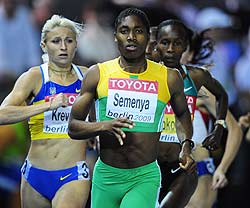
| Semenya's reported condition could have grave medical implications. |
Report: Semenya has male, female sex organs
Associated Press
SYDNEY (AP) - The IAAF said Friday it has received the results of gender tests on South African runner Caster Semenya but is still reviewing them and will not issue any final decision until November.
The International Association of Athletics Federations did not confirm or deny Australian newspaper reports that the recently crowned women's world 800-meter champion has male and female sexual organs.
"We would like to emphasize that these should not be considered as official statements by the IAAF," the federation said in a statement regarding the reports that first appeared in News Limited and Fairfax newspapers.
The Australian newspaper reported in its Friday edition that medical reports on the 18-year-old Semenya indicate she has no ovaries, but rather has internal male testes, which are producing large amounts of testosterone.
"We can officially confirm that gender verification test results will be examined by a group of medical experts," the IAAF said in a written statement. "No decision on the case will be communicated until the IAAF has had the opportunity to complete this examination. We do not expect to make a final decision on this case before the next meeting of the IAAF Council which takes place in Monaco on November 20-21."
At a news conference in Greece on Friday, IAAF general secretary Pierre Weiss, IAAF vice president Sergei Bubka and other association officials refused to make any comment on the Semenya case and distributed the IAAF's written statement to reporters.
The IAAF officials are in the northern Greek city of Thessaloniki for this weekend's World Athletics Final.
After dominating her race at the world championships in Berlin last month, Semenya underwent blood and chromosome tests, as well as a gynecological examination.
Earlier, in an e-mail to The Associated Press, IAAF spokesman Nick Davies said Thursday he couldn't confirm the Australian news reports.
"I simply haven't seen the results," Davies said. "We have received the results from Germany, but they now need to be examined by a group of experts and we will not be in a position to speak to the athlete about them for at least a few weeks.
"After that, depending on the results, we will meet privately with the athlete to discuss further action."
Semenya's father, Jacob, expressed anger when contacted by the AP on Friday morning, saying people who insinuate his daughter is not a woman "are sick. They are crazy."
"I know nothing," he said.
Davies said the newspaper's report "should be treated with caution."
The IAAF has said Semenya probably would keep her medal because the case was not related to a doping matter.
"Our legal advice is that, if she proves to have an advantage because of the male hormones, then it will be extremely difficult to strip the medal off her, since she has not cheated," Davies wrote to the AP. "She was naturally made that way, and she was entered in Berlin by her team and accepted by the IAAF. But let's wait and see once we have the final decision."
Leonard Chuene, the president of Athletics South Africa, told the AP that all he has heard from the IAAF is that the test results will be available in November.
"The results are not in the country yet, so we cannot comment on anything," Chuene said.
South African sports minister Makhenkesi Stofile said he has no doubts about Semenya's gender.
"She's a woman," Stofile said. "She remains our heroine. We must protect her."
More on how "Natural" gets used
Her point is further supported by cinematic representations of sperm and eggs -- here are a few.
First, from the very beginning of “Look Who’s Talking.” There is quiet a difference in the way the egg and the sperm are represented, through music, movement, voice, intelligence, etc. You can watch the whole movie for free on the miracle that is Hulu.com, but the important part is literally the first three minutes.
Then we have the Star Wars version, with sperm as Rebel Forces / fighter pilots and the egg as the Death Star.
Is it funny? Why is it funny?
Finally, I wanted to show this clip from Woody Allen’s “Everything You Ever Wanted to Know about Sex but were Afraid to Ask,” in which he plays a very reluctant sperm.
In addition to the wonderful one-liners (“I’m a graduate of NYU.” “We’re gonna make it.”) watch for Burt Reynolds cameo. But, really, the relevant questions for this course include:
I figure you all have seen a lot more movies or TV clips that involve representations of sperm and eggs. Anything spring to mind? I’d be happy to get other suggestions about what to add to this list."
The Transformative Power of Pop Culture
Foundations
posted by CHARLES MUDEDE on SAT, SEP 5, 2009 at 4:21 PM
I walked by this van and...I could not stop thinking.

A little bit ago, I located Star Wars as the true source of my atheism (or Spinozism, to be more accurate):
[In 1977,] I went into Star Wars a Christian and walked out of it an atheist. Before seeing the movie, I understood the war of Good against Evil to be an entirely Christian one: God vs. Satan. The war happened on the ground, in the sky above, and the immense dark space beyond the moon. The universe was ordered by heaven and hell. So imagine the shock of seeing on the screen a whole different order, a whole different war between the forces of Good and the forces of Evil; a war, furthermore, that made no mention of Jesus, or Lucifer, or the star of Bethlehem, the Romans, the beasts in “The Book of Revelations,” the Last Supper. Yet, in the absolute absence of Christian codes of goodness, I still sided with these other codes and acts of goodness taking place in a faraway galaxy.
In the bright afternoon light of that day, I realized that God was limited, and what was infinite was the Good itself, and that the Good could take on different shapes (Ben Obi-Wan Kenobi, John, Luke Skywalker, Jesus, Princess Leia, Mary).
Similarly, I can attribute my (brand of) Marxism directly to the way James Cameron's Aliens opened my eyes one afternoon in a cineplex in downtown Harare:
The full post is here.
Sexing Young Bodies
Caster Semenya is being treated unfairly
Comment Email Print Share
By Mary Buckheit
Page 2
Archive | Contact
In South Africa, an 18-year-old who was recently victorious at the world track and field championships in Berlin has come under heavy scrutiny. The International Amateur Athletic Federation asked that nation's athletic federation to conduct a gender test on the young star, Caster Semenya, whose blistering time of 1:55.45 in the 800 meters bested the field by a remarkable 2.45 seconds.
The story sent the Interweb buzzing with intrigue. A forced gender test? You mean, we can't tell if a person -- a teenager -- is a man or a woman? The idea was so mind-bending that the initial Associated Press report ranked among the most sent stories last week on ESPN.com.
[+] Enlarge

Oliver Morin/AFP/Getty Images
Caster Semenya's gender is being questioned by defeated opponents in the wake of her victory in
the 800 meters at the world track championships.
It should first be noted that in this age where performance enhancers, cheats and tricks have spared no sport, it isn't unusual for athletes to be asked to prove their competitive integrity. Unfortunately, accusations of cheating or doping after exhibiting a commanding performance are expected. We're suspicious of athletes, and they now must compete beneath ever-present shadows of doubt. When competing for high stakes, they inherently forfeit personal privacy for the purposes of competition and classification.
That isn't want bothers me about the Semenya situation.
In reality, what makes this story so sexy to so many is exactly that. We are determined -- come hell or high water -- to define human beings with binary gender sexing.
Immediately, competitors were calling for her private parts after Semenya had passed them like fence posts. "Just look at her!" fumed Russia's Mariya Savinova, who finished fifth in the 800, 3.23 seconds behind Semenya. "For me, she's not a woman," burned Italy's Elisa Piccione, who finished sixth, 3.36 seconds behind Semenya.
I shudder to think of a global stakeout demanding Caster Semenya prove she is a woman by somehow disproving her apparent masculinity or sufficiently compensating for her lack of femininity -- whatever that is.
How is it that steroid testing, something that clean athletes should be willing to shout about from the rooftops, is done discreetly but an 18-year-old's gender test is the subject of malicious global gossip?
The full article is here.
Columbine

On amazon.com
A review from the New York Times Review of Books and a section from that review:
But the most subtle distortions of the media echo chamber, it seems, did not concern logistics. They concerned motive. As early as two hours into the live coverage of Columbine, news stations began to report that something called the Trench Coat Mafia, a group of disgruntled goths, was possibly behind the attack. Many of the students, watching this coverage on classroom televisions while still trapped inside the building, began to repeat this information to reporters on the outside once they’d escaped. (And it made sense: the killers were wearing trench coats.) And so a loop began, reinforced by four eyewitnesses who said the gunmen were deliberately targeting their victims. One offered such a precise level of detail — the killers were taking aim at “anyone of color, wearing a white hat or playing a sport” — that it proved irresistible, both to students and to members of the media, who (Cullen speculates) were out of their element in this teenage universe, and therefore willing to repeat this rumor whether their “witnesses” had seen the gunmen or not. “Reporters,” the author points out, “would not make that mistake at a car wreck.”
Of course, tragedies often lend themselves to myths, so as to meet the needs of the day. For weeks after Sept. 11, the lovely legend persisted that the Rev. Mychal Judge, a New York Fire Department chaplain, died from falling debris when he took off his helmet to give last rites to a firefighter. As I wrote sometime later in New York magazine, that’s not how he died. But people had a stake in that belief. And Columbine generated a similar tale of spiritual martyrdom. A boy who witnessed the murders in the school library told people afterward that a slain student, a fellow evangelical named Cassie Bernall, was asked by one of the killers if she believed in God. “Yes, I believe in God,” he said she replied. Two other witnesses, both sitting near Cassie, heard no such thing, and Cullen goes on to say that a 911 tape from that day “proved conclusively” that she hadn’t uttered these words. It didn’t matter. The story caught the imagination of the evangelical world, and Cassie’s mother, Misty Bernall, wrote a book, “She Said Yes,” that has since sold more than one million copies.
The Triumph of the Will
Disney = The Impossibility of Being Interesting

Of Mice and Multi-Billion-Dollar Buyouts
posted by PAUL CONSTANT on MON, AUG 31, 2009 at 5:18 PM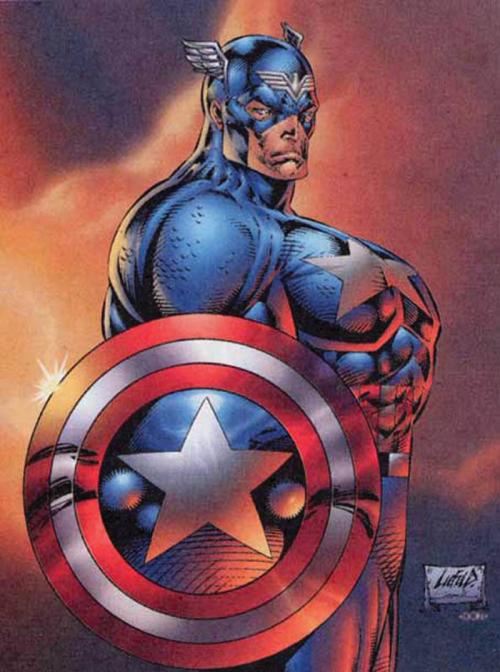
I taught myself how to read on Superman and X-Men comics (and a whole lot of Charlie Brown collections) when I was three years old. I was an avid comics fan (never a collector—I've never bagged or boarded a comic book in my life) until I stopped reading monthly comics back in 1995, when I started paying my own rent. Comics, in particular Marvel Comics, had also become staggeringly awful, and I just couldn't take it anymore. In 1991, Marvel became a publicly owned company, and so their first allegiance became to their shareholders, as opposed to their fans. Comics seemed to be planned and produced based on some sort of weird sales-figure calculus. It was a depressing time to be a funnybook fan.
In 2000, I started reading a lot of comics again, particularly the trade paperbacks you can buy in bookstores. I worked in a bookstore and I got a huge discount, so why not? I mostly read what the kids used to call "alternative comics," even though names like Chris Ware and Dan Clowes are arguably better-known nowadays than "mainstream" names like Brian Michael Bendis.
But I started buying Marvel Comics again in July of 2001, when Grant Morrison and Frank Quitely took over the X-Men. Suddenly, the X-Men weren't wearing tights anymore, and they didn't fight people in tights, either. They opened up international branches and primarily concerned themselves with acceptance. Morrison put away the tired racial allegories that the book had been about since the mid-sixties and instead made the X-Men into an allegory about the fight for gay rights, which seemed at once brave and obvious.
And other Marvel Comics were growing up, too: There was X-Statix, which was a series about mortality, racial blending, reality television and celebrity (a resurrected Princess Diana was even going to become a member of the team before a Marvel executive shot down the plan). Axel Alonso, the editor of Preacher (which has always been and will probably always be my favorite comic series of all time) came to Marvel and immediately set Garth Ennis and Steve Dillon up on a weird, satirical run on The Punisher. Superheroes stopped wearing costumes and most of them dropped their secret identities. The books went from generic superhero fiction to really good genre fiction—crime fiction, sci-fi, even romance comics—and anything seemed possible.
Of course, it wasn't possible, and this deal highlights the impossibility of Marvel Comics ever being interesting ever again.
The full aritcle is here.
WNBA and its Problematic Relationship to Fans

The full article is here.
Lesbian Fan Base

The full article is here.
Sports and Gender

The full article is here.

